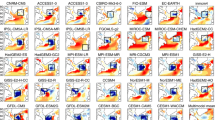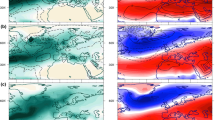Abstract
We have undertaken a comparative study of the mechanisms which drive the response of the Atlantic thermohaline circulation (THC) to a fourfold increase in CO2 over 70 years with stabilisation thereafter in HadCM2 and HadCM3. In both models, the THC changes are driven by surface flux forcing, with advection (and diffusion in HadCM2) acting in the opposite sense to limit the circulation change. In both cases, heat fluxes are more important than those of freshwater. We find that different patterns of heat flux forcing in HadCM2 and HadCM3 are the prime determinants of the differing response in the two models. The increased northerly component to the near surface winds (associated with an increase in reflective low level cloud), leads to enhanced heat loss in the west-central North Atlantic, which in turn tends to steepen the steric gradient and strengthen the THC. By contrast, in HadCM3 the winds become more westerly rather than northerly, there is no dynamically-forced enhancement of surface heat loss, and the heat flux in the North Atlantic continues to be strongly positive, relative to the control, leading to a reduction in the meridional steric gradient, and a weaker overturning circulation. Differences in atmospheric response patterns appear to be caused by improvements to atmospheric and land surface physics, and suggest that the THC response in HadCM2 is less credible than in HadCM3.








Similar content being viewed by others
References
Boer GJ, Flato G, Ramsden D (2000) A transient climate change simulation with greenhouse gases and aerosol forcing: projected climate to the twenty-first century. Clim Dyn 16(6):427–450
Broecker WS (1991) The great ocean conveyor. Oceanography 4:79–89
Cox MD (1984) A primitive equation, three dimensional model of the ocean. Ocean Group Technical Report 1, GFDL, Princeton, 141 pp
Cox PM, Betts RA, Bunton CB, Essery RLH, Rowntree PR, Smith J (1999) The impact of new land surface physics on the GCM simulation of climate and climate sensitivity. Clim Dyn 15:183–203
Dixon KW, Lanzante JR (1999) Global mean surface air temperature and North Atlantic overturning in a suite of coupled GCM climate change experiments. Geophys Res Lett 26:1885–1888
Edwards JM, Slingo A (1996) Studies with a flexible new radiation code. I: choosing a configuration for a large-scale model. Q J R Meteor Soc 122:689–720
Gent PR, McWilliams JC (1990) Isopycnal mixing in ocean circulation models. J Phys Oceanogr 20:150–155
Gordon CC, Cooper R, Wood R, Banks H (1997) The ocean simulation in the Hadley Centre coupled climate model. Int WOCE Newslett 26:9–11
Gordon CC, Cooper R, Senior CA, Banks H, Gregory JM, Johns TC, Mitchell JFB, Wood RA (2000) The simulation of SST, sea ice extents and ocean heat transports in a version of the Hadley Centre coupled model without flux adjustments. Clim Dyn 16:147–168
Gregory D, Kershaw R, Inness PM (1997) Parametrization of momentum transport by convection II: tests in single column and general circulation models. Q J R Meteorol Soc 123:1153–1183
Houghton J, Ding Y, Griggs D, Noguer M, van der Linden P, Dai X, Maskell K, Johnson C (2001) Climate Change 2001: the scientific basis. Contribution of Working Group 1 to the Third Assessment Report of the Intergovernmental Panel on Climate Change. Cambridge University Press, Cambridge
Johns TC, Carnell RE, Crossley JF, Gregory JM, Mitchell JFB, Senior CA, Tett SFB, Wood RA (1997) The second Hadley Centre coupled ocean-atmosphere GCM: model description, spinup and validation. Clim Dyn 13:103–134
Kattenberg A, Giorgi F, Grassl H, Meehl GA, Mitchell JFB, Stouffer RJ, Tokioka T, Weaver AJ, Wigley TML (1996) Climate models—projections of future climate Climate Change 1995. In: Houghton JT, Meira Filho LG, Callander BA, Harris N, Kattenberg A, Maskell K (eds) The science of climate change. Cambridge University Press, Cambridge, pp 285–358
Latif M, Roeckner E, Mikolajewicz U, Voss R (2000) Tropical stabilisation of the thermohaline circulation in a greenhouse warming simulation. J Climate 13:1809–1813
Manabe S, Stouffer RJ (1988) Two stable equilibria of a coupled ocean–atmosphere model. J Climate 1:841–866
Manabe S, Stouffer RJ (1994) Multiple century response of a coupled ocean–atmosphere model to an increase of atmospheric carbon dioxide. J Climate 7:5–23
Manabe S, Stouffer RJ, Spelman MJ, Bryan K (1991) Transient responses of a coupled ocean-atmosphere model to gradual changes of atmospheric CO2. Part I: annual mean response. J Climate 4(8):785–818
Mikolajewicz U, Voss R (2000) The role of the individual air-sea flux components in CO2-induced changes of the ocean’s circulation and climate. Clim Dyn 16:627–642
Mitchell JFB, Johns TC, Ingram WJ, Lowe JA (2000) The effect of stabilising atmospheric carbon dioxide concentrations on global and regional climate change. Geophys Res Let 27:2977–2980
Murphy JM, Mitchell JFB (1995) Transient response of the Hadley Centre coupled ocean-atmosphere model to increasing carbon dioxide. Part II: spatial and temporal structure of response. J Climate 8:57–80
Pope VD, Gallani ML, Rowntree PR, Stratton RA (2000) The impact of new physical parametrizations in the Hadley Centre climate model—HadAM3. Clim Dyn 16:123–146
Sausen R, Barthel K, Hasselmann K, (1988) Coupled ocean–atmosphere models with flux corrections. Clim Dyn 2:154–163
Senior CA, Mitchell JFB (2000) The time dependence of climate sensitivity. Geophys Res Lett 27:2685–2688
Smith RNB (1993) Subsurface, surface and boundary layer processes. Unified Model Documentation Paper 24. The Met Office, Bracknell, Berkshire, UK, 64 pp
Spelman MJ, Bryan K (1991) Transient responses of a coupled ocean-atmosphere model to gradual changes of atmospheric CO2. Part I: annual mean response. J Climate 4(8):785–818
Stommel HM (1961) Thermohaline convection with two stable regimes of flow. Tellus 13:224–230
Thorpe RB, Bigg GR (2000) Modelling the sensitivity of Mediterranean Outflow to anthropogenically forced climate change. Clim Dyn 16:355–368
Thorpe R, Gregory JM, Johns TC, Wood RA, Mitchell JFB (2001) Mechanisms determining the Atlantic thermohaline circulation response to greenhouse gas forcing in a non-flux-adjusted coupled climate model. J Climate 14:3102–3116
Thorpe R, Wood RA, Mitchell JFB (2004) Sensitivity of the modelled thermohaline circulation to the parameterisation of mixing across the Greenland–Scotland ridge. Ocean Modelling 7:259–268
Vellinga M, Wood RA (2002) Global climatic impacts of a collapse of the Atlantic thermohaline circulation. Climatic Change 54(3):251–267
Visbeck M, Marshall J, Haine T, Spall M (1997) On the specification of eddy transfer coefficients in coarse resolution ocean circulation models. J Phys Oceanogr 27:381–402
Williams KD, Senior CA, Mitchell JFB (2001) Transient climate change in the Hadley Centre models: the role of physical processes. J Climate 14(12):2659–2674
Wood RA, Keen AB, Mitchell JFB, Gregory JM (1999)Changing spatial structure of the thermohaline circulation in response to atmospheric CO2 forcing in a climate model. Nature 399:572–575
Acknowledgements
This work was supported by the UK Department of the Environment, Transport, and the regions under contract PECD 7/12/37 and the Public Meteorological Service Research and Development Programme. It has benefited from the valuable comments of Tim Johns and Jonathan Gregory and from two anonymous reviewers, whose perceptive insights improved the quality of the manuscript.
Author information
Authors and Affiliations
Corresponding author
Rights and permissions
About this article
Cite this article
Thorpe, R.B. The impact of changes in atmospheric and land surface physics on the thermohaline circulation response to anthropogenic forcing in HadCM2 and HadCM3. Clim Dyn 24, 449–456 (2005). https://doi.org/10.1007/s00382-004-0493-y
Received:
Accepted:
Published:
Issue Date:
DOI: https://doi.org/10.1007/s00382-004-0493-y




